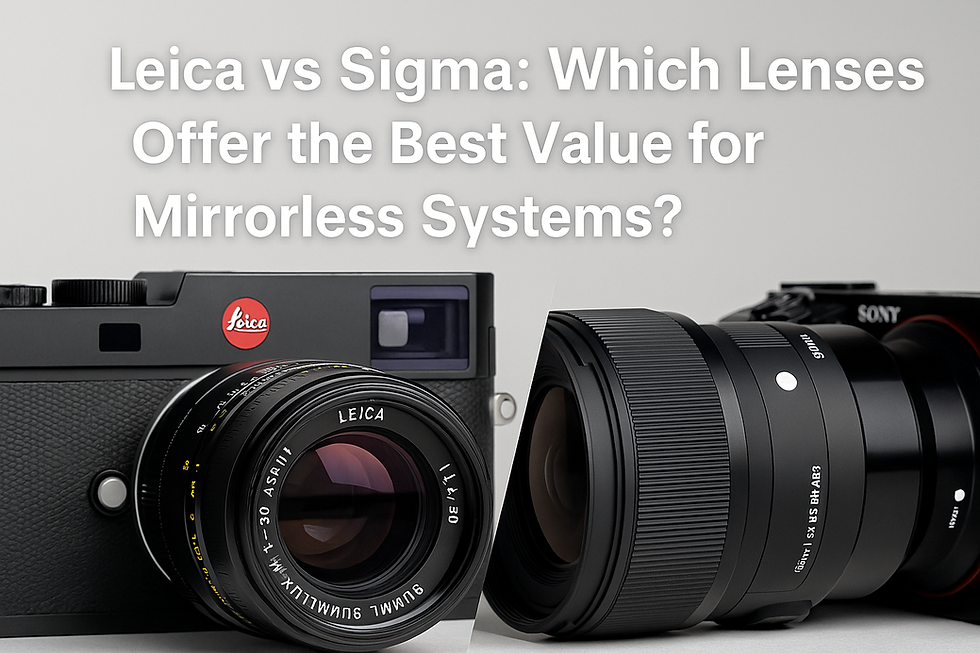Canon vs Sony vs Nikon: Which Makes the Best Camera in 2025?
- SIGMA Photo
- Jul 17
- 4 min read
Introduction
As of 2025, the camera industry has become more competitive than ever, with Canon, Sony, and Nikon standing out as the top three manufacturers. Whether you’re a beginner, a content creator, or a professional photographer, choosing the right brand can significantly affect your image quality, workflow, and long-term upgrade path. But with each brand offering advanced features and high-performing models, the question remains: Which makes the best camera in 2025?
This comparison breaks down each brand’s strengths across categories like image quality, autofocus, lens support, and video performance to help you make an informed choice.
Sony: Innovation Leader in Mirrorless Technology
Sony has maintained its dominance in the mirrorless camera market by continuously pushing innovation. Its Alpha series—including the A7 IV, A7R V, and FX series—are some of the most widely used cameras by both photographers and filmmakers.
Strengths:
Industry-leading autofocus with AI-based subject detection
Excellent video specs, including 4K 120p and 10-bit internal recording
Wide lens compatibility, including strong third-party support (especially from sigma)
Lightweight and compact body designs
Sony's hybrid capabilities make it ideal for content creators, YouTubers, and wedding photographers who need both still and video functionality in one system.
Canon: Balanced Power and Color Science
Canon continues to impress with its EOS R series, particularly with the R5, R6 Mark II, and the newer R1 flagship. While initially slower to fully embrace mirrorless, Canon now offers some of the most balanced full-frame cameras on the market.
Strengths:
Unmatched color science and skin tone rendering
Strong dual-pixel autofocus system
Ergonomic designs and intuitive menus
Excellent lenses in the RF lineup
Although Canon RF-mount is more closed to third-party manufacturers, the quality of Canon’s first-party lenses is outstanding. Their bodies also excel in areas like eye-tracking and high-speed continuous shooting.
Nikon: The Resurgence of a Classic
Nikon has made a major comeback in recent years. With the Z8 and Z9, it has proven that it can rival or exceed Canon and Sony in pro-grade photography. Nikon's mirrorless Z system offers high image resolution, strong dynamic range, and reliable autofocus.
Strengths:
Exceptional image quality, especially in dynamic range and low light
High build quality with durable magnesium alloy bodies
Z-mount lenses are optically superb
Excellent handling for still photography
Nikon is ideal for landscape, portrait, and wildlife photographers who prioritize sharp detail, tonal range, and a traditional shooting experience.
Which Brand Is Best for You?
For Content Creators and Videographers: Sony
If your workflow includes vlogging, YouTube, short films, or hybrid content creation, Sony's cameras like the A7 IV and FX30 offer professional-grade video features in small, reliable bodies. Pairing them with SIGMA DG DN lenses can give you a cost-effective, high-performance setup that’s perfect for fast-paced video production.
For Portrait and Wedding Photography: Canon
Canon excels in rendering accurate skin tones and soft, natural color transitions. The EOS R5 paired with an f/1.2 or f/1.8 prime makes for a beautiful portrait setup. Even budget Canon bodies offer solid autofocus, in-body stabilization, and sharp lenses.
For Landscape and Wildlife Professionals: Nikon
With its high megapixel Z9 and excellent low-light sensors, Nikon is a go-to for photographers who need durability and raw image quality. The Z8 and Zf, paired with Nikon’s 70-200mm or 14-24mm lenses, deliver stunning clarity and control in any environment.
Lens Ecosystem and Third-Party Support
Sony leads the pack when it comes to third-party lens support, with a massive ecosystem of native and third-party lenses, especially from SIGMA. This makes Sony the most flexible brand for creators who want a mix of affordability and performance.
Canon’s RF mount currently offers the least amount of third-party support, which may limit options for budget-conscious users. Nikon is slowly opening up to third parties and has a growing range of Z-mount lenses.
If you're building your kit on a budget, comparing lens options and camera price Pakistan can help you find affordable bodies that work well with SIGMA or native lenses.
Autofocus Showdown
Sony: Advanced AI-driven real-time tracking and Eye AF for humans, animals, and even vehicles.
Canon: Dual Pixel AF II is fast, accurate, and great for both stills and video.
Nikon: Z9 and Z8 offer strong AF performance, with recent firmware updates narrowing the gap with Sony and Canon.
Sony still holds a slight edge in video AF, while Canon is extremely reliable for hybrid shooters. Nikon’s AF continues to improve with each update and is now highly competitive.
Conclusion
So, which camera brand makes the best camera in 2025? The answer depends on your priorities:
Choose Sony if you want cutting-edge autofocus, lightweight systems, and top video specs.
Choose Canon if you value color science, ergonomics, and a well-rounded photo/video system.
Choose Nikon if your focus is still photography, especially landscapes or wildlife, and you want premium image quality.
Each of these giants excels in different areas, and thanks to advancements in mirrorless technology, there are no bad choices—just better matches for your workflow.







Comments